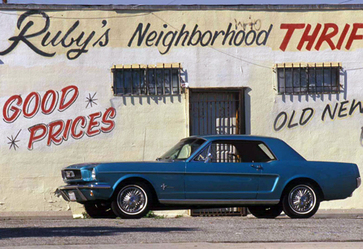|
By accessing or using The Crittenden Automotive Library™/CarsAndRacingStuff.com, you signify your agreement with the Terms of Use on our Legal Information page. Our Privacy Policy is also available there. |

The Legend of Pony Cars
|
|---|
|
|
The Legend of Pony Cars
Geoff Maxted
DriveWrite
August 8, 2013
In the late 1950’s Ford needed a replacement vehicle for their ageing Thunderbird. By 1964 the company had come up with a car that was to become an icon of American motoring - the Mustang.
Instantly the Mustang became recognisable by its galloping pony badge. Presumably without too much difficulty and brain-storming the editor of Car Life magazine at the time worked out that if you matched the equine logo with the car’s name you could coin the expression ‘pony car’.
This was the car that set the precedent for the type of automobile that would fall under that nickname although other manufacturers were slow to cash in on the popularity of this type of sports car. The Mustang set the standard: two doors and four seats set in a short deck behind a long bonnet (which Americans will persist in calling a hood) all sitting behind an ‘open mouthed’ grill. Emphasis was given to sporty styling although the original base model was not especially performance orientated. Above all the price should be in reach of most buyers.
One very interesting point that is pertinent to modern cars like the Vauxhall Adam or Citroen DS3, the marketing for the car was very much aimed at a youth market, both in styling and image - a pop market Model T. Ford made much of an extensive range of options enabling new owners to individualise and personalise their Mustang. So not such a new idea then?
The simplicity of the design made the car an overnight success although the other car makers thought it might be a flash in the pan and held back from competing. The only other similar car of the time was the Plymouth Barracuda which was launched by Chrysler just before the Mustang but without the fanfare.
The Barracuda was meant to be a low-cost version of the company’s Valiant model so Plymouth had inadvertently and unknowingly stumbled on the Ford plan.
Over the next few years other cars appeared that fell under the pony car classification, notably the Chevrolet Camaro, the Pontiac Firebird and the Dodge Challenger. The deal was done and American youth was eternally grateful as indeed we still are today.
The original pony cars looked great but under the skin were not particularly powerful, based as they were on other models for economies of scale. It didn’t take long for far-sighted petrol heads like Carroll Shelby to realise that these desirable motors could do with some more muscle. Thus the famed muscle cars of the USA were born. Most of the ponies gained a bigger tougher brother. The Mustang begat the Torino GT, the Barracuda begat the Roadrunner and the Challenger begat the Charger of Bullit Fame.
As early as 1969 the legend of those original pony cars began to fade as updated models and their successors moved into the mainstream. Never mind, you can still buy a Mustang today but it is as far removed from the original as the Starship Enterprise is from Stephenson’s Rocket. It’s called progress but who wouldn’t want a car that was simple, easy to fix at home with off-the-shelf parts, was cheap to buy and above all looked great. Those were the golden years. Gone but not forgotten.



















